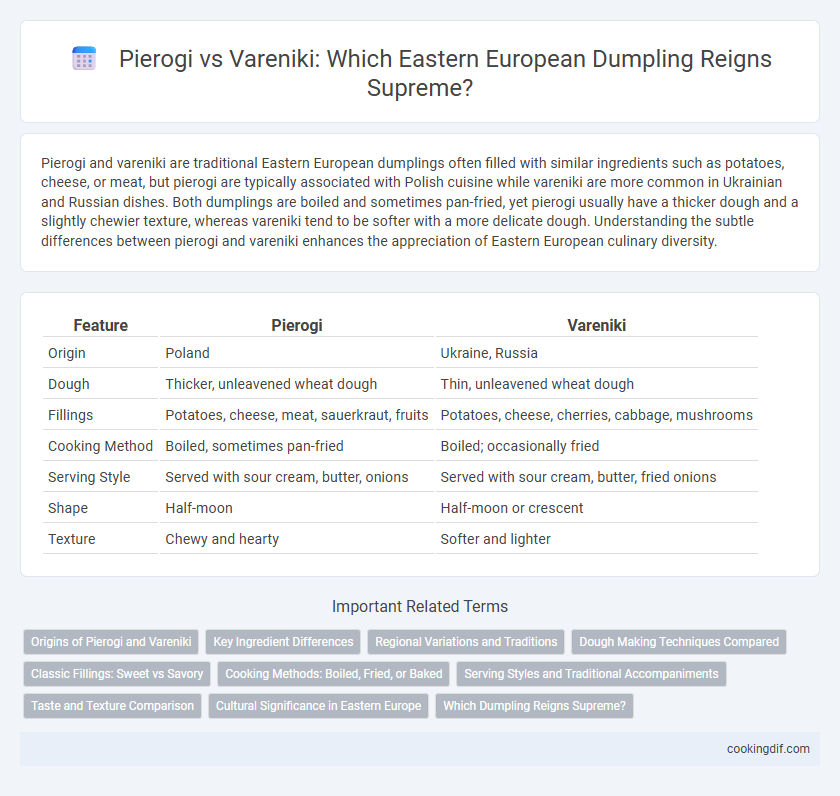Pierogi and vareniki are traditional Eastern European dumplings often filled with similar ingredients such as potatoes, cheese, or meat, but pierogi are typically associated with Polish cuisine while vareniki are more common in Ukrainian and Russian dishes. Both dumplings are boiled and sometimes pan-fried, yet pierogi usually have a thicker dough and a slightly chewier texture, whereas vareniki tend to be softer with a more delicate dough. Understanding the subtle differences between pierogi and vareniki enhances the appreciation of Eastern European culinary diversity.
Table of Comparison
| Feature | Pierogi | Vareniki |
|---|---|---|
| Origin | Poland | Ukraine, Russia |
| Dough | Thicker, unleavened wheat dough | Thin, unleavened wheat dough |
| Fillings | Potatoes, cheese, meat, sauerkraut, fruits | Potatoes, cheese, cherries, cabbage, mushrooms |
| Cooking Method | Boiled, sometimes pan-fried | Boiled; occasionally fried |
| Serving Style | Served with sour cream, butter, onions | Served with sour cream, butter, fried onions |
| Shape | Half-moon | Half-moon or crescent |
| Texture | Chewy and hearty | Softer and lighter |
Origins of Pierogi and Vareniki
Pierogi originated in Poland and have been a staple of Polish cuisine since the Middle Ages, traditionally filled with potatoes, cheese, or meat. Vareniki, hailing from Ukraine and Russia, closely resemble pierogi but often include sweet fillings like cherries or farmers' cheese, highlighting regional variations. Both dumplings reflect deep-rooted Eastern European culinary traditions, shaped by geography and cultural exchanges.
Key Ingredient Differences
Pierogi and vareniki share a similar dough base made from flour, water, and eggs, but their key ingredient differences lie in the fillings; pierogi often feature savory fillings like potato, cheese, sauerkraut, or meat, whereas vareniki tend to include sweeter options such as cherries, berries, or sweetened quark. Pierogi fillings may also incorporate fried onions and bacon bits, enhancing their savory profile, while vareniki fillings prioritize simple, fresh, and often slightly tart fruits. These distinct filling choices reflect regional preferences and cultural culinary traditions across Eastern Europe.
Regional Variations and Traditions
Pierogi and vareniki are traditional Eastern European dumplings with distinct regional variations reflecting cultural preferences. Pierogi, popular in Poland, often feature fillings such as potatoes, cheese, sauerkraut, or meat, and are typically boiled then pan-fried, emphasizing a crispy texture. Vareniki, common in Ukraine and Russia, share similar fillings but are usually boiled and served with sour cream or butter, highlighting a softer, more tender bite linked to Slavic culinary traditions.
Dough Making Techniques Compared
Pierogi dough typically incorporates a mixture of all-purpose flour, eggs, water, and a pinch of salt, resulting in a slightly elastic texture ideal for boiling or frying. Vareniki dough is generally softer and more pliable, made with flour, water, and occasionally a small amount of oil or sour cream, allowing for a tender and delicate finish after steaming or boiling. Both doughs emphasize elasticity and tackiness but differ in hydration and fat content, influencing the dumplings' texture and traditional cooking methods.
Classic Fillings: Sweet vs Savory
Pierogi and vareniki, staple Eastern European dumplings, showcase distinct classic fillings emphasizing sweet and savory flavors. Pierogi often include savory fillings like potato and cheese, sauerkraut, or ground meat, while sweet variants feature fruit fillings such as blueberries or cherries. Vareniki traditionally highlight sweet fillings like cottage cheese or cherries, alongside savory options including potatoes, cabbage, or mushrooms, reflecting regional culinary preferences.
Cooking Methods: Boiled, Fried, or Baked
Pierogi and vareniki, traditional Eastern European dumplings, share similar cooking methods including boiling, frying, and baking, each offering unique texture variations. Boiling preserves the soft, tender dough characteristic of both dumplings, while frying adds a crispy exterior enhancing flavors often filled with potatoes, cheese, or fruit. Baking provides a golden crust and is less common but favored for specific savory fillings, showcasing regional culinary adaptations in countries like Poland and Ukraine.
Serving Styles and Traditional Accompaniments
Pierogi are traditionally served boiled or pan-fried, often topped with fried onions, sour cream, or butter and accompanied by sauerkraut or mushrooms in Polish cuisine. Vareniki, common in Ukrainian and Russian culinary traditions, are typically boiled and served with sour cream and sometimes sweetened with sugar or paired with cherries for a dessert variation. Both dumplings emphasize rich, creamy accompaniments that complement their hearty fillings, reflecting their cultural roots.
Taste and Texture Comparison
Pierogi feature a chewier dough and often contain savory fillings like potato, cheese, or meat, delivering a hearty and slightly dense bite. Vareniki have a softer, thinner dough with a smoother texture, typically filled with sweeter or more delicate ingredients such as farmer's cheese or fruit. The taste of pierogi is usually richer and more robust, while vareniki offer a lighter, more subtle flavor profile.
Cultural Significance in Eastern Europe
Pierogi and vareniki both hold deep cultural significance across Eastern Europe, serving as iconic symbols of national identity and culinary heritage in Poland and Ukraine respectively. Pierogi are traditionally associated with Polish festive rituals and celebrations, often filled with ingredients like potatoes, cheese, and sauerkraut, reflecting regional agricultural practices. Vareniki, on the other hand, embody Ukrainian customs with a broader variety of fillings including cherries and cottage cheese, illustrating the diversity of Ukrainian folklore and family traditions.
Which Dumpling Reigns Supreme?
Pierogi and vareniki stand as iconic Eastern European dumplings, each boasting unique fillings and regional variations that captivate diverse palates. Pierogi often feature savory fillings like sauerkraut and mushrooms, while vareniki traditionally include sweeter ingredients such as cherries or potatoes, reflecting cultural culinary preferences. The supreme choice hinges on flavor profiles and texture preferences, with pierogi favored for hearty, robust tastes and vareniki prized for their delicate, often sweet appeal.
Pierogi vs Vareniki for Eastern European dumplings Infographic

 cookingdif.com
cookingdif.com